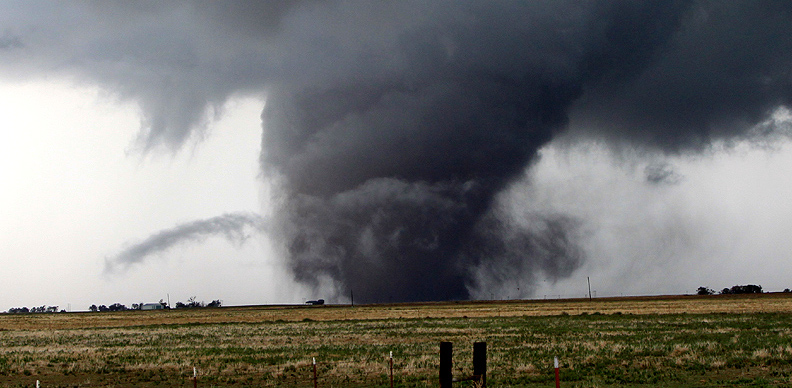The tornado is the most violent storm on Earth. A tornado is a rapidly rotating column of air extending to the ground from a thunderstorm cloud. The path width of a tornado is usually very narrow, but can range up to a half-mile or more in the most extreme cases. Tornadoes usually only last a few minutes, but a few can last for much longer, traveling along the ground for several miles. Tornadoes can remain almost stationary, or can race across the countryside at speeds over 50 mph. Violent winds in and near the tornado can cause incredible destruction, and can generate flying debris, which is the main thing that hurts people in tornadoes.
Tornado Safety
Keeping informed about the weather is the best way to avoid being caught in a tornado or severe thunderstorm. Your local National Weather Service Forecast Office provides information about dangerous weather in your area, and you should keep a close eye on this information whenever storms threaten your area. A battery operated NOAA Weather Radio with a warning alarm feature should be a part of your information system!
It’s also critical that you think about tornado safety long before there’s a storm on the horizon, and plan what you will do to stay safe no matter where you may be when storms threaten.
When a severe storm or tornado threatens, remember these basic guidelines:
GET IN – get as far inside a strong building as you can, away from doors and windows
GET DOWN – get to the lowest floor
COVER UP – use whatever you can to protect yourself from flying or falling debris
•A reinforced underground storm shelter, storm cellar, enclosed basement or safe room are usually the safest places in a tornado. Underground shelters get you out of the way of flying and falling debris, which is a tornado’s most lethal weapon.
•If you cannot get underground, remember the basic guidelines. Get as far inside the strongest building you can find. Stay away from doors, windows and other openings to the outside. Put as many walls between you and the outside as you can.
•Get as low as you can. Go to the lowest floor of the building you’re in.
•Cover up to protect yourself from flying and falling debris. Use whatever you can find – pillows, blankets, sleeping bags, mattresses. Wearing a helmet or hardhat will help protect your head from debris.
•Being outdoors, in a mobile home, or in a vehicle are all unsafe in a tornado or severe thunderstorm. Find stronger shelter before the storm arrives and remember to get in, get down and cover up.
More information
•Tornado Project Online has a wealth of tornado information as well as with tornado myths, tornado oddities, personal experiences, tornado chasing and tornado safety.
•FEMA Are You Ready? has terms and tips for what to do before and during a tornado and preparing a safe room.
•American Red Cross: Tornado suggests how to prepare a home tornado plan, assemble a disaster supplies kit and what to do before, during and after a tornado.
•Historical information on Oklahoma tornadoes.
•Frequently Asked Questions about Tornadoes.
•FEMA tornado site for kids.
•Preparing a Safe Room has guidelines and instructions for building a safe room.

